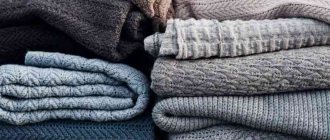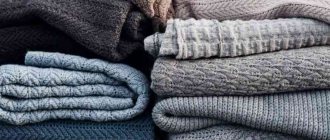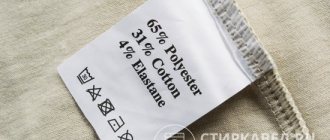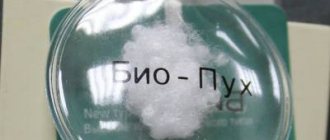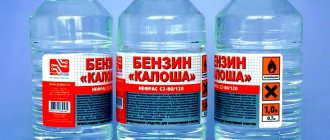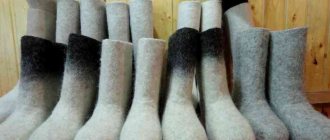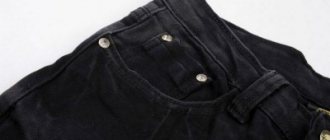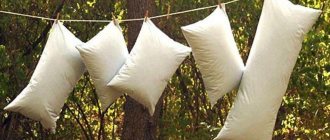Socks are an essential part of the wardrobe, without which no modern person can do. They are worn every day, so they are the ones that need washing more often than other things.
Few people realize, but it is the improper treatment of socks that leads to early wear, the appearance of difficult to remove stains and discoloration.
To make them last longer, you need to wash them correctly. For information on how to wash socks from dirt at home (in the washing machine and by hand), read the article.
Preparing dirty items for washing
Before you start washing, your socks need to be properly prepared. Basic recommendations:
Sort socks by color. White, black and colored items are washed separately.- Remove all visible dirt from socks. This could be threads, hair and other dirt.
- Turn the socks inside out. Sometimes it happens that small objects, pebbles and other debris get inside the product.
- Walk over the surface of the product with a machine to remove pellets.
If there are serious stains on the socks, they need to be soaked. If machine processing is intended, then you can select a special “wash with soak” program. To enhance the effect, a stain remover is added to the powder.
Soaking items during hand washing can be done using several methods:
- In a basin with the selected detergent.
- In polyethylene film. Socks are soaped and placed in a bag, leaving for 30-60 minutes.
When the preparatory activities are completed, you can begin washing the product.
Machine and hand wash
Each housewife chooses her own washing method. This choice may be due to personal preference or the lack of certain amenities. Each method has its own secrets that will help speed up the process and achieve a good result.
You can throw a couple of tennis balls into the drum of the washing machine, which will increase the washing efficiency. You can also add baking soda (200 ml) to the rinse aid compartment. Before loading laundry into the washing machine, be sure to turn your socks inside out.
Hand washing requires the correct choice of water temperature. Socks with protein contamination (blood) should not be immersed in hot water, otherwise the protein will coagulate and envelop the fabric fibers. It is better to wash such stains in cool water. Heavy contamination requires a temperature of about 40 degrees.
Machine washable
For machine washing, it is important to choose the right mode. Use the soak function to tackle tough stains
The washing mode and temperature should be selected according to the type of material of the socks. Products made from cotton, synthetics and nylon can be washed at 60 degrees using any powder.
Socks can be washed with other clothes of the same material. It is best to combine products with household items
It is important that the type and degree of contamination match. Children's socks should be washed separately from adults'.
Pairs often get confused in the machine. This is especially inconvenient if you have similar socks. Special clothespins that connect socks will come to the rescue.
Everyone has encountered cases when socks got tangled in other things and pairs were lost. Washing bags for small items will fit perfectly when combining clothes and socks. These bags ensure that you find all your clothes after washing.
Wash by hand
Many housewives prefer to wash their socks by hand. The reason may be a lack of trust in the washing machine, a reluctance to run a drum with a small amount of clothes, or the absence of a machine at all.
For such cases, it is important to learn the features of hand washing.
Classic laundry soap can handle common stains. Just rub it on your clothes and leave it on for a few hours. Then put representatives of one pair on your palms (like mittens) and rub them vigorously against each other. You will need about 3-7 minutes to clean trampled marks.
It is better to wash wool products by hand. Capricious material can deteriorate if handled roughly. For the cleaning procedure, choose special detergents and rinses for wool.
It is difficult to wash heavily soiled socks by hand. It is better to first soak things in a soapy solution, and only then proceed with the procedure. Men's socks are often more difficult to wash, so soaking them is not recommended.
How to wash in an automatic washing machine?
To prevent washing in a machine from negatively affecting the condition of your socks, you need to follow certain rules. They relate to selecting the optimal program, setting the temperature and choosing a detergent.
It is not necessary to wash each pair separately. For one-time loading, the following combinations are allowed: “white and light-colored items”, “black and dark blue socks”, “colored and plain dark ones”.
The general instructions are as follows:
- sort socks by color;
- clean them of debris and hair;
- turn the products inside out;
- load into the washing machine and wait until the cycle ends.
At what temperature?
The temperature you choose depends on the type of fabric the socks are made from. Most often there are no labels on them.
Manufacturers indicate washing recommendations on the label . Therefore, before throwing it away, you need to familiarize yourself with the care tips for specific products.
Cotton, synthetic and nylon socks are washed at a temperature no higher than 50-60 degrees. Products made from delicate fabrics, such as wool or silk, are processed in thirty-degree water.
In what mode (program)?
When choosing a washing program, you need to consider the type of fabric of your socks. If these are classic summer or terry products, then any mode will do. The main thing is that the temperature does not exceed 60 degrees.
Wool socks are washed using the “wool”, “delicate” or “gentle” wash program. It is recommended to turn off the spin or reduce the speed to 400.
Which detergent should you choose?
To wash socks in a machine, use regular laundry detergent.
If items made from delicate fabrics are to be processed, it is better to use a liquid detergent. It activates at low temperatures and rinses well.
It is important to consider the color of the fabric and the type of washing powder . Do not use products containing bleaches to process colored items. It is quite applicable to white socks.
When washing by hand, use laundry or any other soap. If you have stubborn stains, you can use folk remedies.
Preparatory activities
When purchasing such items, pay attention to the information on the label. As a rule, the manufacturer marks the size and gives recommendations on choosing a washing mode.
Before washing you will have to prepare:
- divide things by color shades - put black ones away from white ones, select woolen items, and generally leave children's socks for a separate procedure;
- Before loading into the drum, each sock is turned inside out and shaken off dust;
- To wash socks in pairs, they are placed in a special bag or secured with clips. Sometimes some housewives “catch” the products with a stitch, and small holes appear in these places due to the intense impact of the washing machine.
How to do it manually?
Washing socks by hand is easy. There are 2 main methods:
- Using palm friction . Socks are put on your hands, moistened, soaped and rubbed against each other.
- In the basin . Detergent is diluted in it and the products are soaked. Difficult stains can be rubbed with your hands or a brush.
Sometimes they resort to unusual washing methods, for example, placing socks in plastic bottles with soapy water. Such containers are loaded into the trunk of a car and transported throughout the day. All that remains is to rinse the socks and hang them out to dry.
Read more about how to hand wash socks here.
Folk remedies for dirt and black soles
Sometimes classic cleaning products cannot cope with heavy stains. In this case, folk methods come to the rescue. They allow you to remove blackness from the sole, stubborn stains and stains.
Turpentine
Turpentine helps get rid of gray on white socks. Apply it as follows:
Dilute 3 tablespoons of turpentine in 10 liters of water.- Add 2 tbsp to the resulting composition. l. washing powder. Shake until completely dissolved.
- Soak socks overnight.
- Wash and rinse the item thoroughly.
Turpentine has a pungent odor, so you need to work with it carefully, protecting your respiratory system with a mask.
Bleaching
The most accessible means for whitening socks is bleach or bleach. With its help, you can get rid of difficult stains and whiten dirt that has gotten into your soles.
Mode of application:
- dissolve 2 tbsp in 2 liters of warm water. l. whiteness, add 100 g of washing powder and mix thoroughly;
- soak the socks in the resulting solution and leave for 1-2 hours;
- manually rub areas with stubborn stains;
- Rinse the product thoroughly.
Cotton and linen items can be soaked in bleach. Colored items and socks made from delicate fabrics will not tolerate such treatment.
Hydrogen peroxide and ammonia
A mixture of hydrogen peroxide and ammonia has a high cleaning ability. This composition allows you to quickly get rid of difficult stains.
Mode of application:
- For one part of ammonia take 2 parts of ammonia.
- The resulting composition is applied to contaminated areas and left for 15-30 minutes.
- Wash socks by hand, paying special attention to stains.
- Rinse the item thoroughly.
When working with ammonia solution and hydrogen peroxide, you need to wear gloves in a well-ventilated area.
Do I need to soak?
Soaking is always important when heavily soiled, and socks are no exception. If this is not done, dirt and dust can be quite firmly absorbed into the fabric fibers and then even several washing procedures will not help restore them to freshness. There are two methods to soak very dirty socks:
- 10-12 hours before washing, immerse them in a basin of warm water, in which a couple of tablespoons of powder intended for hand washing are mixed in advance. Heavy stains on light-colored fabric should be soaked with bleach.
- another “grandmother’s” method: areas that are too dirty are soaped with laundry soap and wrapped in a plastic bag overnight.
You should know that soaking should not occur in very hot water, above 40 degrees. Excessively hot water will not only not help remove contaminants, but, on the contrary, will promote the absorption of dirt particles from fabric fibers.
Processing features depending on color: white, dark, colored
Dirt is more noticeable on white socks than on dark ones. Therefore, you have to wash them more often.
To remove blackness and prevent yellowing of the fabric, you can periodically use bleaching compounds. These can be chlorine-containing products, but you need to take into account that they lead to tissue damage.
The fibers lose strength and holes will appear on the product faster. Therefore, preference should be given to delicate bleaches containing enzymes and active oxygen.
Examples of such means are:
- Vanish Oxi Action Gold (the cost of 0.45 ml gel is about 145 rubles),
- Boss Maximum (for 0.45 powder you will have to pay about 50 rubles).
Colored socks are washed separately from other items, as they tend to fade and stain light-colored fabrics.
To care for them, stain removers that do not contain a bleaching component are used . The optimal washing temperature is 40 degrees.
Black socks are considered the easiest to care for. The stains on them are not so noticeable, so they are washed less often than white items.
However, they can only be processed with plain items . Even firmly dyed fabric causes white items to turn grey.
Read about the rules for washing white socks by hand here.
Nuances for different materials
Depending on the material from which the socks are made, the features of caring for them will differ. The main recommendations are presented in the table.
| Woolen | Cotton, linen | Bamboo | Synthetics | |
| Washing temperature | 30 degrees | Up to 50-60 degrees | Up to 40 degrees | Up to 60 degrees |
| Washing mode | “wool”, “delicate”, “gentle” | “cotton - intensive wash”, “cotton - gentle wash” (the mode is selected depending on the degree of contamination) | “cotton – gentle wash”, “delicate” | “synthetics – gentle wash”, “synthetics – intensive wash” |
| Number of revolutions | Disabled, or no more than 400 | 600-800 | ||
| Detergent | Liquid detergent compositions | Powder, soap, gels | Liquid detergents | Powder, soap gel |
Socks made of delicate fabrics, such as wool, are recommended to be processed by hand.
For nail fungus
Nail fungus is a contagious disease . Microscopic particles of mycelium settle on all surfaces, including items of clothing.
To prevent the infection from spreading and leading to repeated self-infection, you need to wash your socks correctly.
Basic moments:
- When washing by hand, you need to use gloves;
- Items should be machine washed at maximum temperatures;
- It is recommended to boil socks every 3-4 washes;
- You can only load things into the washing machine that belong to a sick person.
To destroy fungal spores after washing, it is recommended to iron socks.
Read more about washing socks if you have fungus here.
Is it possible to wash socks with panties?
At first glance, this does not seem to be a significant dilemma, but with proper attention to hygiene, this issue is relevant. If we think from the point of view of cleanliness, then any items that are sufficiently soiled should not be washed with underwear.
Also, soaking socks that come into contact with shoes, dust and street dirt with panties is not entirely hygienic.
When it comes to washing in a machine, everything is different. After a cycle of complete washing, rinsing and spinning the panties and socks, all items will be equally clean. Therefore, such joint washing is a purely personal matter and depends on preferences.
What is possible and what is not?
To save time and washing powder, people often throw not only socks, but also other things into the washing machine drum. However, the joint processing of some wardrobe elements is unacceptable . First of all, this applies to underwear.
With T-shirts
You can wash socks with T-shirts. However, you need to take into account the manufacturer's recommendations that are indicated on them. It is important that the products are the same color and from similar fabrics.
White T-shirts and black socks should not be loaded into the drum. Woolen and silk items are washed separately, as they require delicate treatment.
With panties
It is not recommended to wash socks with underwear . There is only one reason - hygiene standards. Socks come into contact not only with a person’s foot, but also with the floor covering and the inside of the shoe.
Therefore, not only dirt can settle on them, but also various bacteria, which, during washing at low temperatures, can move to the laundry and then to the intimate area.
If lace underwear is washed in a machine, then choose the delicate cycle. It won't fit most socks. They require more intensive processing. Under no circumstances should children's underpants and socks be washed at the same time.
Is it possible and how to properly wash socks and panties together in a washing machine? Read here.
With shirts
Shirts are washed either by hand or on a delicate cycle. Other programs may cause damage to the product.
If there are socks in the laundry basket that are the same color as the shirts and also require careful handling, then washing them together is acceptable.
With towels
Many housewives wash socks with kitchen towels. The main thing is that the products do not stain each other . As for personal towels, it is not recommended to load them into the drum together with socks for hygienic reasons.
Socks are worn on your feet, so a wide variety of germs can settle on them. A towel is a personal hygiene item that is used for the face, body, and intimate area.
These two things should not be combined. As an exception, such washing is possible, but at maximum temperatures.
We perform whitening
If washing is done in a machine, then baking soda in the amount of one glass is poured into the tray for washing powders. The second option is to dilute six grams of boric acid in two liters of water. Some people prefer to use lemon juice. Things should remain in each of these solutions for no more than three hours.
Cotton items are soaked to restore color as follows:
- take any bleach in the amount of two spoons, mix with washing powder (100 grams), fill everything with two liters of water;
- In the prepared mixture, the socks are soaked overnight.
Alcohol or ammonia in the amount of two spoons, diluted with a liter of water, returns the whiteness of products quite well.
When washing white socks, select the “Cotton” mode and set the temperature to high. Drying is carried out outdoors or in a dryer; it is not recommended to use a battery to prevent yellowish spots from appearing on the materials.
Laundry bag
A bag for washing socks is a mesh product that is secured with laces or a zipper.
Its use allows you to solve several problems at once:
- Avoid socks getting tangled if they are loaded in large quantities at once or with other underwear.
- Extend the service life of the product. The mesh will be subject to friction against the drum of the washing machine, not the socks themselves.
- Do not harm the quality of the socks during spinning.
There are several types of bags. Small cases hold up to 2 pairs of socks. The cost of such a bag is 270 rubles.
You can also find large nets on sale, divided into 3 sections by partitions . For example, a product from Artmoon (250 rubles per piece). You can purchase mesh in hardware stores and online markets.
How to avoid losing socks in the wash
The disappearance of one sock from a pair during washing is a great mystery of humanity, the answer to which has not yet been found. Socks often disappear, getting stuck in the gap between the drum and the inner walls of the machine. You can solve this problem using several simple methods:
- To prevent one pair of socks from getting lost in the wash, you should put them in a mesh bag. You can sew it yourself, buy it ready-made in a store, or use a bag from a shoe package. Such a bag can be washed along with the rest of your clothes without fear of losing pairs.
- Connect identical socks with special plastic clothespins.
How to dry quickly at home?
You need to dry your socks naturally. If washing was carried out with a spin cycle, the products will dry completely in 3-4 hours. You can speed up this process by using an iron by ironing the pair from the wrong side several times. The steam function must be turned off.
Do not place socks on the radiator. This can lead to unsightly streaks and stains.
Special drying conditions are required only for woolen products. They are washed without spinning, after which they are laid out on a wire rack in a horizontal position. If you hang them, they may lose their shape.
Getting rid of odor
An unpleasant odor is a consequence of excessive sweating or prolonged wear. To eliminate it, you need to change the water several times during washing. To enhance the cleaning effect, you can use freshly squeezed lemon juice or orange peel. With the right approach, the odor neutralization process will not take much time.
Particular attention should be paid to detergents. Their composition is the determining factor. By following the recommendations on how to wash socks in a washing machine or by hand, you can extend the life of the products.
Important Tips
To wash your socks and not render them unusable, you must follow the following recommendations:
- Socks are turned inside out before washing. This will allow you to maintain their attractive appearance for a long time.
- When washing socks with other items at the same time, you need to take into account the recommendations that apply to all products.
- When loading a large number of pairs, you need to use a special mesh.
White socks should be washed after each wear. This will prevent dirt from penetrating deep into the fabric. Bleach can be used periodically.
You will find maximum useful information about washing clothes and various fabric products here.
Washing light-colored socks
Light-colored socks quickly lose their purity and freshness, despite the period of wear and careful care for them.
And several washing cycles completely lead to the loss of their original appearance - changing their color to a grayer or yellower, pellets are formed.
And they are more difficult to wash than other colors. But with some knowledge, these phenomena can be leveled out:
- White socks should ideally be washed after each wear;
- ammonia combined with ammonia will help maintain whiteness and, in addition, soften the water. You need to mix them two tablespoons per liter of water;
- lather them with soap and leave for a certain time (soap can be replaced with scented bleaches);
- If you do not want to use chemicals, you can replace them with lemon by squeezing a few drops onto contaminated areas. Over time, citric acid will whiten the socks;
- Boiling is an old method for washing light-colored items. A few slices of lemon and a little washing powder are immersed in water. Socks should be placed in water during the first stages of heating. Boiling should not last more than 15 minutes;
- Soaking in a mixture of water and boric acid at the rate of one tablespoon of acid per liter of water will help keep socks white. Socks are dipped in this mixture for a couple of hours and then washed.
